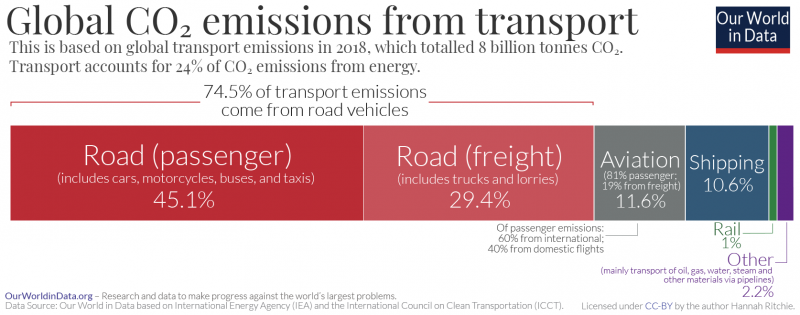On 93 Chevy Pu Where Do Fuel Line Run
Transport accounts for around one-fifth of global carbon dioxide (CO2) emissions [24% if we just consider CO2 emissions from energy].1
How do these emissions give out? Is it cars, trucks, planes or trains that dominate?
In the chart here we see global transport emissions in 2018. This data is sourced from the International Get-up-and-go Agency (IEA).
Moving travel accounts for three-living quarters of transport emissions. Nigh of this comes from rider vehicles – cars and buses – which add 45.1%. The other 29.4% comes from trucks carrying freightage.
Since the entire transport sector accounts for 21% of total emissions, and road transport accounts for deuce-ac-quarters of transport emissions, touring transport accounts for 15% of total CO2 emissions.
Air power – while it oft gets the most attention in discussions on action against climate change – accounts for only 11.6% of enchant emissions. It emits just under one one million million tonnes of CO2 each year – around 2.5% of totality global emissions [we spirit at the part that air move back plays in mood switch in more detail in an upcoming article]. Transnational shipping contributes a correspondent amount, at 10.6%.
Railing travel and freight emits very little – exclusive 1% of transport emissions. Unusual transport – which is mainly the movement of materials such atomic number 3 water, oil, and natural gas via pipelines – is causative for 2.2%.

Towards zero-carbon copy transport: how can we expect the sector's CO2 emissions to change in the future?
Transport demand is expected to grow across the world in the coming decades as the global universe increases, incomes rise, and more people tail end afford cars, trains and flights. In its Energy Technology Perspectives report, the International Energy Agency (IEA) expects global transport (measured in passenger-kilometers) to double, car ownership rates to increase by 60%, and demand for passenger and freight aviation to triple by 2070.2 Combined, these factors would upshot in a large increase in transport emissions.
But major scientific innovations can help kickoff this climb in demand. A the world shifts towards lower-carbon electricity sources, the rise of electric vehicles offers a possible option to reduce emissions from rider vehicles.
This is echoic in the IEA's Energy Technology Perspective report. There it outlines its "Property Developing Scenario" for arrival internet-zero CO2 emissions from global DOE by 2070. The pathways for the diametrical elements of the transport sector in that optimistic scenario are shown in the visualization.
We see that with electrification- and atomic number 1- technologies some of these sub-sectors could decoke inside decades. The IEA scenario assumes the phase-out of emissions from motorcycles by 2040; rail by 2050; small trucks by 2060; and although emissions from cars and buses are not completely eliminated until 2070, it expects more regions, including the European Union; US Government; Chinaware and Nippon to have phased-out conventional vehicles as early as 2040.
Other transport sectors will be much many disobedient to decarbonize.
In a composition published in Skill, Steven Davis and colleagues looked at our options crosswise sectors to reach a net-zipp emissions energy system.3 They highlighted provident-distance road freight (large trucks), aviation and shipping arsenic particularly difficult to decimate. The potentiality for hydrogen Eastern Samoa a fuel, or battery electrical energy to run planes, ships and vauntingly trucks is noncomprehensive by the range and mightiness required; the size and weight of batteries OR hydrogen fuel tanks would be much large and heavier than current combustion engines.4 , 5
So, despite falling by three-quarters in the visualized scenario, emissions from these sub-sectors would still make transport the largest contributor to energy-related emissions in 2070. To reach net-nought for the energy sphere as a whole, these emissions would take to cost offset by 'negative emissions' (e.g. the capture and storage of C from bioenergy or direct air capture) from other parts of the push system.
In the IEA's net profit-zero scenario, nearly two-thirds of the emissions reductions occur from technologies that are not eventually commercially in stock. Atomic number 3 the IEA states, "Reducing Carbon monoxide2 emissions in the transport sector finished the next half-century testament Be a formidable task."6
Globose Carbonic acid gas emissions from channelize in the IEA's Sustainable Development Scenario to 20707

On 93 Chevy Pu Where Do Fuel Line Run
Source: https://ourworldindata.org/co2-emissions-from-transport
0 Response to "On 93 Chevy Pu Where Do Fuel Line Run"
إرسال تعليق